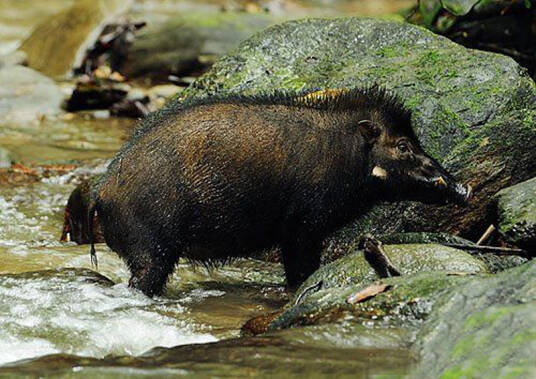Sus bucculentus
IUCN
LCBasic Information
Scientific classification
- name:Sus bucculentus
- Scientific Name:Sus bucculentus,ndo-chinese Warty Pig、Heude's Pig、 Vietnam Warty Pig,Vietnamese wild boar, big-mouthed wild boar
- Outline:Ungulata
- Family:Artiodactyla Suidae Sus
Vital signs
- length:1.5-2m
- Weight:50kg and above
- lifetime:No verification information
Feature
A mysterious species
Distribution and Habitat
Distributed only in Vietnam and Laos, the last known individual was hunted in 1995 and is probably extinct.
Found only in the Annamit Mountains of Vietnam and Laos, but the small number of specimens precludes even a rough range map. The typical habitat in the region is moist broadleaf forest mixed with bamboo and palm trees.
Appearance
The Indochinese wild boar is similar in appearance to the Eurasian wild boar, ranging in length from about 1.5 to 2 meters and weighing more than 50 kilograms. Its hair is coarse and hard, and can be used as a bristle brush. This is an enigmatic species, described in 1892 based on two skulls. No complete specimens have been studied, and no living animals have been identified or observed. Skull features suggest that the Indochinese wild boar is similar to the Javan wild boar. The debate over whether the Indochinese wild boar represents a separate species, a hybrid, or a Eurasian wild boar with extreme skull features is unresolved.
Details
Indochinese wild boar (scientific name: Sus bucculentus) is also known as Indo-chinese Warty Pig, Heude's Pig, Vietnam Warty Pig, and has no subspecies.

The Indochinese wild boar was described in two skulls collected in southern Vietnam in 1892, allegedly from near Ho Chi Minh City in the Dong Nai Valley. Another specimen (an incomplete but apparently male subadult skull) was reported from Ban Ni Giang in the Annamit Mountains of the Lao People's Democratic Republic, east of the Mekong River (18º19'N, 104º44'E).
In 1997, Groves et al. announced the rediscovery of the Indochinese wild pig species in Laos, which had been unrecorded since it was first described in 1892. Although the identification of the new specimen was initially based on morphology, the authors also used a 7% sequence divergence from the common Eurasian wild pig S. scrofa (based on analysis of 327 base pairs encoding mitochondrial 12S ribosomal RNA) as support for species status. Given the large divergence reported for a relatively conserved gene and the absence of a sequence in any public database, the scientists analyzed an additional tissue sample from the specimen and found only a 0.6% divergence. A more extensive analysis placed the specimen within the clade of the Eurasian wild boar, raising questions about the species status of the Indochinese wild boar and demonstrating the need for phylogenetic and morphological evidence in species determination.
Due to the doubtful taxonomic status of the Indochinese wild boar, it is listed as "extinct" with no reliable information on its population status, and the possible cause of its extinction may be hybridization with "hybrid" type pigs.
Listed in the IUCN Red List of Threatened Species 2016 ver 3.1 - Extinct (EX).
Protect wildlife and eliminate bushmeat.
Maintaining ecological balance is everyone's responsibility!








